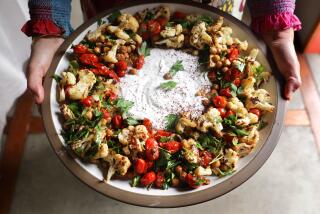It’s Yummy Being Green
- Share via
When it gets chilly and damp, that’s the time for long-cooked greens, with their soft, creamy textures and developed flavors. And there’s nothing that takes away the chill like a big pot of cooked greens.
Usually, when you talk about cooked greens, you’re talking about a large family of mostly Southern vegetables: mustards, kale, collard and turnip. (One soul food restaurant with a healthy sense of priorities boasts on its menu: “Turnips, with bottoms.”)
Mustards come in two varieties: regular and Texas. The leaves of Texas mustard greens are a little frillier and are lighter in texture than regular mustard greens, and the mustard flavor is a touch more pronounced.
These days, kale is usually found lining salad bars. Its thick leaves are unusually resistant to wilting from cold; in fact, it’s supposed to taste better when harvested after the first frost. It has a mild, sweet flavor, rather like cabbage.
Collards taste like kale, only more so. They’re also a little bit harder to find, since their thick, heavily ribbed leaves are not quite as pretty.
In Southern cooking, you rarely cook a single variety of greens, with the sometime exception of mustards. Rather, several types of greens are combined in a pot with a chunk of salt pork or bacon and water to cover. They are then cooked for, quite literally, hours.
What emerges is a dish more soup than vegetable (indeed, the liquid is called “potlikker” and, with a big piece of corn bread, it is guaranteed to raise the dead--or, at least, the flu-ridden).
But greens don’t have to be cooked forever. In fact, when you find very young mustard greens (four to six inches long), they’re very nice raw, torn up in mixed green salads.
Other greens, being sturdier than mustards, must be cooked, but they can be treated more like spinach. Try braising them with a little salt pork for no more than 15 to 20 minutes.



